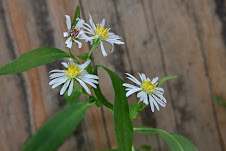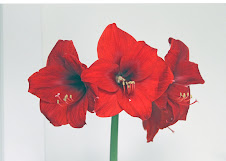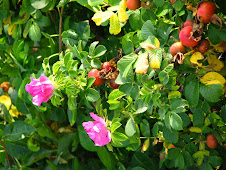Wednesday, November 14, 2012
Indian Strawberry
Indian Wild Strawberry is a wild flower which has a bad reputation. I thought this invasive groundcover was poisonous, but around the world many eat not just the berry but the whole plant. The internet is full of information on the plant’s health and medicinal benefits.
Duchesnea indica has many common names. Indian Strawberry, False Strawberry, Mock Strawberry, and She Mei are a few of its nicknames. In fact the plant is now placed in the Rose Family with the scientific name of Potentilla indica, (poh-ten-TIL-ah inn-DEE-kuh). The Rosoideae (Rose Family) has been subject to reorganization based on recent genetic analysis. It has been shown that both the wild strawberries (formerly Fragaria) and the Indian strawberries (formerly Duchesnea) are actually all part of the larger Potentilla within the Rose Family.
This miniature plant looks like a common edible strawberry plant except for size and a yellow rather than white flower. This wildflower will grow anywhere from shade to full sun. The perennial herb is naturalized throughout the U.S. and found growing in shady and sunny places in woods and grassy slopes.
The low, trailing vine has roots at the nodes. These matted roots send out runners to set new plants. The plant is invasive with quickly spreading runners and many seeded fruit. Since the plant is more or less evergreen in southern ranges; it provides a lovely groundcover for difficult areas.
Leaves are alternate light green and trifoliate, each leaflet being serrate and ovate, entire plant is finely haired. The small, yellow flowers have 5 petals, first flowers bloom in April and blooms throughout the summer till fall. If the weather is mild; the plant will bloom all year. The fruit is small, about ½ inches round, with many seeds.
The plant originated in Asia and Europe and is popular in India as a powerful medicinal herb.
Harvest young edible leaves in spring and fruit as soon as it ripens. Gather entire plant in late summer, dry for later herb use.
The fruit is 3.4% sugar, 1.5% protein and 1.6% ash. It has 6.3 mg of Vitamin C per 100 ml of juice. The fruit’s taste ranges from tart to tasteless to mild watermelon flavor. The fruit is used to cure skin diseases. The entire plant is edible and medicinal. The leaves can be included is a stew.
The whole plant is used as an anticoagulant, antiseptic, depurative and febrifuge. An infusion of the flowers is used to activate the blood circulation.. Indian Strawberry is used extensively in China as a medicinal herb and is being studied for its ability to stop the HIV virus and some forms of cancer from spreading through the body.
For years I’ve spent hours zoning away while I pull up this tiny wildflower. A habit I must break and instead direct my destroying energy to wire grass.
For additional info: http://www.naturesherbal.com/Indian_Strawberry.htm
and http://www.eattheweeds.com/potentilla-indica-mistaken-identity-2/. Also
http://www.sierrapotomac.org/W_Needham/IndianStrawberry_080617.htm
Sunday, October 21, 2012
Jerusalem Artichoke (Heliantus tuberosus)
This is a wildflower weed that I am always trying to eradicate from my yard. I break off the seed tops and dig up the roots to no avail. This monster is called a Jerusalem artichoke (Helianthus tuberosus). However, the plant is not related to the artichoke or Jerusalem, but is a species of sunflower. Classified in the sunflower family the plant is distinguished from other species of sunflowers by underground tubers.
In August bright yellow flower heads are produced at ends of the stems. Each flower contains 8 to 20 outer yellow flowers or ray flowers that enclose the dark yellow to brown disk flowers.
The first leaves are opposite and covered with short hairs. These large leaves range from 4 to 10 inches long and 1 ½ to 5 inches wide. Mature leaves are longer and taper to a point with the upper leaves alternate on the stem. All leaves have toothed margins.
The Jerusalem artichoke is also called sunroot, sunchoke, earth apple or topinambour. The tuber is used as a root vegetable. This perennial may grow up to 10 feet tall and is found throughout the eastern half of the United States and along the Pacific coast.
The wildflower was first cultivated by Native American. In 1805 Lewis & Clark dined on the tubers. A French explorer noted that the edible tuber tasted like an artichoke. In the 2002 Nice Festival for the Heritage of the French Cuisine the Jerusalem artichoke was awarded the “best soup vegetable”.
The tuber can be thinly sliced and added to a salad or steamed in a stew. The tubers may cause flatulence. Unlike potatoes, they do not contain starch, but inulin, a fiber, that changes into a natural sugar.
The tubers are highly nutritious. Jerusalem artichokes have 650 mg potassium per 1 cup (150g) serving. They are also high in iron, and contain 10-12% of the US RDA of fiber, niacin, thiamine, phosphorus and copper. I have bought sunchokes in grocery stores in California.
In Germany the tubers are used to make a spirit called “Jerusalem artichoke brandy”.
You might want to try Jerusalem artichokes tubers. However, the quality of the edible tubers degrades unless the plants are dug up and replanted in fertile soil. Better to wait until Jan. or Feb. before digging up the tuber. This gives time for the tuber to become sweeter. Beware; a small piece of tuber will grow if left in the ground, making the hardy plant a potential weed. Even a piece of a root can make an additional 75 to as many as 200 tubers by fall's end.
Jerusalem artichokes can be used as animal feed, but must be washed before being fed to most animals. Except pigs, which forage and safely eat them directly from the soil. Does anyone have some pigs they can lend me?
For additional info "http://http://www.ppws.vt.edu/scott/weed_id/heltu.htm" and
"http://en.wikipedia.org/wiki/Jerusalem_artichoke#cite_note-purdue-1"
Sunday, March 25, 2012
Chickweed
We all have chickweed growing somewhere in our yard. Chickweed, also called Starwort, the Latin name is Stellaria media.
This weakly stemmed wildflower is many branched and usually grows along the ground in thick masses. Chickweed prefers to grow in lawns and disturbed areas which contain some shade and moisture. Its height is from 3 to 8 inches with trailing stems up to 16 inches long. Small white flowers are in terminal clusters or solitary. The fruit is a many seeded capsule with seeds that germinate in the fall. Flowering is from February through December. The range of this annual is throughout most of North America except Arctic.
This edible weed was introduced from Eurasia and is a favorite food of chickens and wild birds. Chickweed is also eaten worldwide as a salad or cooked.
They are as numerous in species as they are in region. Most are succulent and have white flowers, and all with practically the same edible and medicinal values. They all exhibit a very interesting trait (they sleep) termed the 'Sleep of Plants,' every night the leaves fold over the tender buds and the new shoots.
Chickweeds are Medicinal and edible, they are very nutritious, high in vitamins and minerals, can be added to salads or cooked as a pot herb, tasting somewhat like spinach. I’ve added chickweed to salads and omelets – delicious. The major plant constituents in Chickweed are Ascorbic-acid (vitamin C), Beta-carotene (vitamin A), Calcium, Gamma-linolenic-acid, Flavonoids, Hentriacontanol, Magnesium, Niacin, Oleic-acid, Potassium, Riboflavin, Rutin, Selenium, Triterpenoid saponins, Thiamin, and Zinc. The whole plant is used in alternative medicine.
New research indicates its use as an effective antihistamine. A extract is also used externally to treat rheumatic pains, wounds and ulcers. It can be applied as a medicinal poultice and will relieve any kind of eczema and is effective wherever there are fragile superficial veins or itching skin conditions.
To make sure you are using the correct plant the stem should not have a sticky milky sap. If you look carefully at the stem; there is a small line of thin hairs that run up one side. When the line of thin hairs run into a pair of leaves the line of hairs switch to the other side of the stem. Another defining characteristic is to slightly bend the stem and slowly pull apart. There will be a small thread running through the stems that is somewhat elastic.
Lawn lovers, according to Green Deane who writes a blog on edible weeds, “… have given chickweed a bad rap. Instead of lawn lovers pulling out a clump of chickweed and having it for dinner, they spend a lot of green to get rid of the green. Its demise is a million-dollar business, which is a large expense and a waste of food. Raw, it tastes exactly like corn silk, if you’ve ever tried that. Cooked it is similar to spinach though the texture is different. It can be added to soups or stews, but not until the last five minutes to prevent overcooking. Unlike many wild edibles, the chickweed’s stems, leaves, flowers and seeds are all edible. It does hold nitrates and people with allergies to daisies might want to pass it by.”
Chickweed Pie is best hot; it will keep one to two days in the refrigerator and can be reheated in a microwave oven.
One 10-inch pie crust
3 cups chopped chickweed
1 cup diced slab bacon
½ cup finely chopped onion
3 large eggs
1½ cups sour cream
1 tablespoon all-purpose flour
½ teaspoon grated nutmeg
Preheat oven to 325 degrees. Line a 10-inch pie dish with crust and make a raised border around the rim to prevent filling from overflowing during baking.
To prepare chickweed, remove all leaves, twigs and root ends, reserving only the greenest, leafiest parts. Rinse thoroughly in a colander and gently dry with paper towels. Bunch the chickweed together into a ball and chop it with a sharp knife until reduced to a confetti texture. Measure, then put chickweed in a large bowl.
Fry diced bacon in a skillet until it begins to brown, then add onion. Cook about 3 minutes, or until onion wilts. Using a slotted spoon, transfer bacon and onions to bowl with chickweed. Discard drippings from pan.
In a separate bowl, beat eggs until lemon colored, then add sour cream, flour and nutmeg. Add egg mixture to chickweed, onions and bacon. Spread filling evenly in the pie shell and pat down firmly with a spoon. Bake 45 to 50 minutes, or until pie has set in center and top looks golden.
—Adapted from Pennsylvania Dutch Country Cooking by William Woys Weaver (Abbeville Press, 1993).
This weakly stemmed wildflower is many branched and usually grows along the ground in thick masses. Chickweed prefers to grow in lawns and disturbed areas which contain some shade and moisture. Its height is from 3 to 8 inches with trailing stems up to 16 inches long. Small white flowers are in terminal clusters or solitary. The fruit is a many seeded capsule with seeds that germinate in the fall. Flowering is from February through December. The range of this annual is throughout most of North America except Arctic.
This edible weed was introduced from Eurasia and is a favorite food of chickens and wild birds. Chickweed is also eaten worldwide as a salad or cooked.
They are as numerous in species as they are in region. Most are succulent and have white flowers, and all with practically the same edible and medicinal values. They all exhibit a very interesting trait (they sleep) termed the 'Sleep of Plants,' every night the leaves fold over the tender buds and the new shoots.
Chickweeds are Medicinal and edible, they are very nutritious, high in vitamins and minerals, can be added to salads or cooked as a pot herb, tasting somewhat like spinach. I’ve added chickweed to salads and omelets – delicious. The major plant constituents in Chickweed are Ascorbic-acid (vitamin C), Beta-carotene (vitamin A), Calcium, Gamma-linolenic-acid, Flavonoids, Hentriacontanol, Magnesium, Niacin, Oleic-acid, Potassium, Riboflavin, Rutin, Selenium, Triterpenoid saponins, Thiamin, and Zinc. The whole plant is used in alternative medicine.
New research indicates its use as an effective antihistamine. A extract is also used externally to treat rheumatic pains, wounds and ulcers. It can be applied as a medicinal poultice and will relieve any kind of eczema and is effective wherever there are fragile superficial veins or itching skin conditions.
To make sure you are using the correct plant the stem should not have a sticky milky sap. If you look carefully at the stem; there is a small line of thin hairs that run up one side. When the line of thin hairs run into a pair of leaves the line of hairs switch to the other side of the stem. Another defining characteristic is to slightly bend the stem and slowly pull apart. There will be a small thread running through the stems that is somewhat elastic.
Lawn lovers, according to Green Deane who writes a blog on edible weeds, “… have given chickweed a bad rap. Instead of lawn lovers pulling out a clump of chickweed and having it for dinner, they spend a lot of green to get rid of the green. Its demise is a million-dollar business, which is a large expense and a waste of food. Raw, it tastes exactly like corn silk, if you’ve ever tried that. Cooked it is similar to spinach though the texture is different. It can be added to soups or stews, but not until the last five minutes to prevent overcooking. Unlike many wild edibles, the chickweed’s stems, leaves, flowers and seeds are all edible. It does hold nitrates and people with allergies to daisies might want to pass it by.”
Chickweed Pie is best hot; it will keep one to two days in the refrigerator and can be reheated in a microwave oven.
One 10-inch pie crust
3 cups chopped chickweed
1 cup diced slab bacon
½ cup finely chopped onion
3 large eggs
1½ cups sour cream
1 tablespoon all-purpose flour
½ teaspoon grated nutmeg
Preheat oven to 325 degrees. Line a 10-inch pie dish with crust and make a raised border around the rim to prevent filling from overflowing during baking.
To prepare chickweed, remove all leaves, twigs and root ends, reserving only the greenest, leafiest parts. Rinse thoroughly in a colander and gently dry with paper towels. Bunch the chickweed together into a ball and chop it with a sharp knife until reduced to a confetti texture. Measure, then put chickweed in a large bowl.
Fry diced bacon in a skillet until it begins to brown, then add onion. Cook about 3 minutes, or until onion wilts. Using a slotted spoon, transfer bacon and onions to bowl with chickweed. Discard drippings from pan.
In a separate bowl, beat eggs until lemon colored, then add sour cream, flour and nutmeg. Add egg mixture to chickweed, onions and bacon. Spread filling evenly in the pie shell and pat down firmly with a spoon. Bake 45 to 50 minutes, or until pie has set in center and top looks golden.
—Adapted from Pennsylvania Dutch Country Cooking by William Woys Weaver (Abbeville Press, 1993).
Subscribe to:
Comments (Atom)




















LP_gardening_2666.jpg)
LP_gardening_2668.jpg)

LP_garden_2819.jpg)

LP_flower_0563.jpg)
LP_flower_0577.jpg)
LP_flower_0545.jpg)
LP_flower_0555.jpg)
LP_flower_0539.jpg)
LP_dog_0470.jpg)
LP_snow_0467.jpg)
LP_dog_0349.jpg)
LP_tree_8153.jpg)
LP_5028.jpg)
LP_flowers_3940.jpg)

LP-grass_0889.jpg)
LP_redfox_1651.jpg)
LP_squirrel_6978.jpg)
LP_flower_6936.jpg)
LP_squirrel_6864.jpg)
LP-deer_4773.jpg)
LP_4521.jpg)
LP_1251.jpg)
LP_4585.jpg)
LP_3784.jpg)
LP_3759.jpg)
LP_3811.jpg)
LP_3816.jpg)
LP_3847.jpg)
LP_0870.jpg)
LP_4183.jpg)
LP_0891.jpg)
LP_3175.jpg)
LP_3577.jpg)

LP_3068.jpg)
LP_3058.jpg)
LP_3562.jpg)
LP_0118.jpg)
LP_3407.jpg)
LP_3150.jpg)
LP_3011+(2).jpg)
LP_3020.jpg)
LP_2830.jpg)
LP_2782.jpg)
LP_2828.jpg)
LP_1746.jpg)
LP_2648.jpg)
LP_2666.jpg)
LP_2668.jpg)
LP_2493.jpg)
LP_2611crop.jpg)


LP_2588.jpg)






LP_2126.jpg)
LP_2122.jpg)





